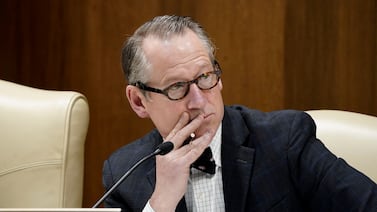Sign up for Chalkbeat New York’s free daily newsletter to get essential news about NYC’s public schools delivered to your inbox.
High school teacher Steve Lazar was ecstatic when he learned of SUNY’s new plan to automatically admit seniors who are in the top 10% of their class to a slew of campuses.
Lazar, who spent much of his career working at non-selective New York City high schools that predominantly serve low-income students of color, thought the new policy would give his students a leg up in an admissions process that often favors families with time and resources.
But the fine print worried Lazar. The new policy, called SUNY’s “Top 10% Promise,” requires students meet criteria beyond having a top GPA, such as posting SAT or ACT scores above certain thresholds, passing two Advanced Placement exams, or being on track to earn advanced diplomas that require additional tests.
The result: Black and Latino students in New York City are far less likely to receive an automatic admissions offer than their white and Asian American peers, according to a Chalkbeat analysis of city data.
Black or Latino students represented 51% of the top students in each school’s graduating class last year — but they made up just 36% of students who were in the top 10% of their class and met SUNY’s additional criteria for automatic admission. Meanwhile, white and Asian American students represented 47% of students at the top of their high school class, yet accounted for 61% of students who would have received a direct admissions offer.
Lazar said he was “unbelievably dismayed” by the expected impact of the extra rules. “My question is why have they put in these arbitrary criteria that are going to disproportionately exclude a Black and brown population?”
Chalkbeat evaluated the impact of the SUNY direct admissions policy on New York City public school students by requesting Education Department data for last year’s graduating class. The direct admissions policy is set to take effect for current high school seniors, so the figures may shift but still offer a close approximation of which students are likely to receive direct admissions offers.
The additional test score requirements would have excluded about 2,400 New York City students in last year’s class from receiving an automatic offer — meaning only about 6% of city seniors would qualify for the SUNY program.
Several states, including California and Texas, have rolled out direct admissions programs, a model that has grown in popularity across the country. The SUNY program includes automatic admission to nine campuses, including Purchase College, University at Albany, and Stony Brook University. Binghamton University, one of the state’s top public colleges, is not included.
Students in dozens of public school districts across the state are eligible for the program in its first year, including New York City. Officials plan to eventually expand it to all districts. A major goal is to keep top-performing students in New York for college and reduce hurdles for students from low-income households who may struggle to navigate the admissions process.
“It removes the barrier of doing the application,” SUNY Chancellor John King told the Daily News. “It removes the barrier of students maybe questioning if they’re going to be able to get into a top college.”
Asked why SUNY added additional criteria beyond ranking in the top of a high school class, SUNY spokesperson Holly Liapis said the purpose is “to ensure that students are academically prepared to succeed in college.”
Liapis stressed that students who aren’t offered automatic admission may still apply to SUNY campuses. She also pointed to the Educational Opportunity Program, a separate initiative that offers spots to low-income students who fell below traditional admissions criteria and comes with extra support.
Researchers: SUNY criteria exclude students who could thrive
Multiple experts who have studied automatic admissions policies in other states, including Texas and California, said there are some promising elements of SUNY’s approach, including directly admitting students rather than requiring students to apply even if they automatically qualify.
Still, they said it’s difficult to predict whether the program would shift students’ college enrollment decisions or increase campus diversity, noting any changes would likely be modest.
Zachary Bleemer, an economics professor at Princeton University who has studied direct admissions elsewhere, said SUNY’s additional criteria beyond course grades seemed more restrictive than in some other states — and could lock out students who would benefit from a SUNY education.
Bleemer’s research on a direct enrollment program in California found that students with high GPAs but relatively low test scores benefited from attending a selective University of California school, notching significantly higher college graduation rates and earnings compared with students who just missed the admissions cutoff and went to less selective schools.
“I think it’s very easy for state administrators to believe that top high school students with low test scores would not be able to take advantage of the educational resources provided by large public universities,” he said. “And that’s often wrong.”
Some New York City educators said they support the direct admissions program. Nitzan Ziv, a college and career counselor at Harvest Collegiate High School in Manhattan, said the handful of students who qualified for the program were thrilled to learn a few weeks ago that they automatically had a spot at SUNY school.
“It’s a great morale boost,” Nitzan said, noting that a handful of the school’s students got into all nine SUNY campuses participating in the direct admissions program.
But she’s unsure it will change their enrollment decisions, as the school’s top students are already plugged into the college admissions process and often attend more selective schools.
She also echoed concerns that some of the school’s strongest students are being excluded by the additional test score requirements.
“It just seems like it’s cutting out students who are excellent candidates for no reason,” she said.
Alex Zimmerman is a reporter for Chalkbeat New York, covering NYC public schools. Contact Alex at azimmerman@chalkbeat.org.







